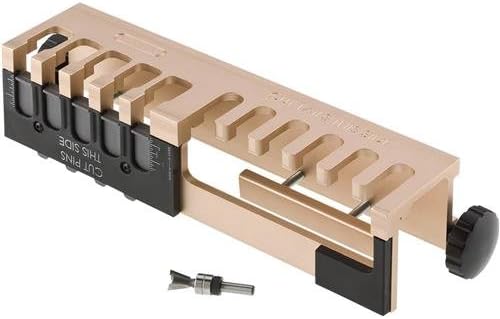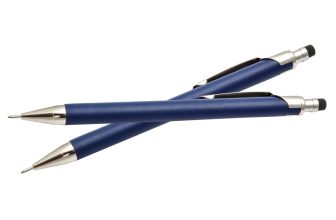Contents
Dovetail joints are beautiful and can add an exquisite and premium look to a finished workpiece, but they’re very time-consuming to cut manually and require a high degree of precision. Dovetail jigs make these joints significantly easier and more manageable, and they allow even novice woodworkers to produce professional-looking pieces.
Dovetail Jigs all feature different total project widths, and aren’t all suitable for thicker workpieces, so we put together these reviews and a comprehensive buyer’s guide to help you choose the product that will serve you best.
Best Dovetail Jigs – Our Top Picks
BuildEazy.com may earn a commission if you purchase a product through one of our links.
PORTER-CABLE is known for making high-performance tools that are incredibly durable, and we were pleased to see that their dovetail jig matched our expectations.
This jig is made entirely of very heavy-duty metal, so we’re confident it will stand up to countless projects and some workshop abuse.
PORTER-CABLE is also confident in their product, as they offer a 90-day satisfaction guarantee in addition to 1 year of free service and a 3-year limited warranty. That means you’ll have 3 months to return the jig if it’s not for you, they will ensure proper and smooth functionality for up to 12 months, and they will replace broken pieces or malfunctioning parts for up to 36 months.
It weighs a hefty 25 pounds, so while we have no doubt it will have a long lifespan, it will be quite challenging to move around your shop.
It features strong clamps to attach it securely to a workbench, offering stability and confidence in your cuts. The clamps that hold your workpiece in place are equally as strong and reliable.
It can handle stock that is up to 12 inches long and 1⅛” thick, so you’ll find it useful for most standard projects.
It features several different alignment lines and depth markers to make correctly setting up your workpiece as straightforward as possible. It can be a bit tricky to use at first, but once you get used to it, it’s simple to set up your stock and align your cuts.
It comes with multiple inserts for routing out different shapes. You can use this tool to cut dovetail joints, box joints, half-blind dovetails, and dovetail rabbets, making it one of the most versatile dovetail jigs available.
General Tools 861 Portable Aluminum Dovetail Jig
General Tools focuses on making budget tools, so this dovetail jig is an excellent option for beginners and woodworkers on a budget and provides excellent value for the money.
It’s made of aluminum, so it offers decent durability while weighing only 2.94 pounds. It’s easy to relocate to different work surfaces or maneuver while using it on a router table.
You can attach it to a work table, but we feel the clamp isn’t secure enough to offer confidence while routing. As such, it should be clamped to your workpiece and used on a router table instead.
It has open ends to make it suitable for any width board, but you’ll have to move it precisely to continue cutting dovetails once you reach the end of the jig.
It doesn’t have any inserts to allow you to cut different patterns, so you will only be able to route dovetails and box joints with this jig.
It comes with a router bit that fits the jig, so you won’t need to go out and buy another piece of equipment to use it.
Leigh Super 12 Inch Dovetail Jig
Leigh Tools specializes in precision joinery tools, so it was unsurprising to find that this was the best dovetail jig for precision. It has a high degree of adjustability, allowing you to set where on your workpiece you want your dovetails. You can move each finger easily and with accuracy.
It’s moderately heavy at 14.15 pounds, but it’s light enough to relocate to different work surfaces without too much effort.
It’s made of durable metal components and features solid construction, so we’re confident it will last through many joinery projects.
There are clamps for affixing the jig securely to a workbench that will hold your piece steady as you work, offering you confidence as you cut. The clamps to hold your stock are also strong and keep your workpiece from moving under the weight and vibration of your router.
It doesn’t come with any attachments or inserts, so you will only be able to cut through-dovetails, half-blind dovetails, and box joints. You’ll need an additional tool if you want to cut rabbets. This product is on the more expensive end, so adding additional jigs for different joinery options may force you to go over your budget.
It can accept boards up to 12” in width and can handle stock that is up to ¾” thick, so it will be useful for most typical woodworking applications.
Lastly, the jig comes with excellent instructions on setting your depth and includes tips for using your jig, so it’s straightforward to use.
Woodstock D2796 12-Inch Dovetail Jig
Woodstock International has been making tools for hobbyists and professional woodworkers for over 15 years, and we think their experience helped to make this dovetail jig one of the most user-friendly and easy to use.
The jig is made entirely out of steel and aluminum, so we have no doubt that it will last for many years and help tackle countless projects. The heavy-duty metal components do make it a bit bulky and difficult to move around your shop, as the jig weighs 20 pounds.
It has one of our favorite clamping methods, using easily adjustable knobs and a locking lever. It’s simple to make changes to adapt to different workbenches as well as different sizes of stock, and the clamps hold securely to keep you safe while you cut.
It can accommodate workpieces up to 12” wide and 1¼” thick, so you’ll find that it’s easy to use with most projects that require dovetail joinery.
It only includes one aluminum guide, which means it can only cut through-dovetails, half-blind dovetails, and box joints. You would need to purchase additional jigs for rabbets or other joinery styles.
Leigh Super 18” Dovetail Jig
This 18-inch dovetail jig from Leigh is made of very durable metal components and will likely last through countless projects. It weighs in at 16.71 pounds, so the metal pieces make it rather heavy and somewhat difficult to move around your workshop.
Like all Leigh products we’ve used, this jig offers an impressive amount of adjustability and precision. Each dovetail finger on this jig can be adjusted in either direction, allowing you to make custom spacing on your workpieces.
It includes powerful clamps to secure the jig to your workbench as well as to hold your stock in place while you cut. It offers excellent stability and will give you confidence during operation.
The manual included with this jig offers detailed instructions on how to set your workpieces for accurate, tight joints, and it offers tips on how to adapt the jig to different projects and preferences.
The adjustable fingers aren’t detachable, so you can’t purchase different inserts for other joinery types. As such, you’ll only be able to cut dovetails and box joints with this jig and will need additional tools for cutting rabbets.
This is one of the most expensive dovetail jigs we tested. It’s a premium product that offers precision to make it one of the best options for professionals, but it may be prohibitively expensive for beginners or woodworkers on a budget.
Keller Dovetail System 135-1500
Keller specializes in making dovetail jigs, and their experience makes this the most straightforward jig to use. There are no adjustments or attached clamps to complicate use.
However, the lack of alignment lines and depth guides makes this the hardest dovetail jig to use correctly. While the process is straightforward, getting your cuts to be accurate requires more practice than most other jigs.
It can handle stock up to ¾” thick, so it’s useful for everything from ⅛”-thick stock all the way up to 1-by material. The fact that it doesn’t have clamps means that it’s suitable for workpieces of any width, and you’ll just need to unclamp the jig from your stock and align it precisely to continue beyond 12”.
It’s a simple jig made of durable metal, so it’s all but indestructible. Despite being constructed of high-quality material, it’s very lightweight at just 1.65 pounds.
It comes with ball-bearing template guides, a straight bit for box joints, and a dovetail bit, so you won’t need guide brushes or anything other than a router and a workbench to get started using this jig.
It’s a bit on the expensive side, but it has excellent versatility and can make a great addition to any beginner or experienced woodworker’s shop.
Buyer’s Guide
There are many dovetail jigs to choose from, and it can be hard to decide on one that will be ideal for your specific projects. Below are the most important factors to consider when shopping for one that will be most suitable for your skill level now and adaptable for use as you progress in your work.
Benefits of a Good Dovetail Jig
You may be wondering why a dovetail jig is useful in the first place. If you’ve cut dovetail joints manually before, you already know how challenging it can be to get them to line up perfectly.
Manual dovetail jigs require far cheaper tools but require a very high degree of precision and patience to make them accurate and visually appealing. Each dovetail and dovetail inlet in your joint need to be measured very carefully and then cut with a hand saw.
Since there should be no gap between any surfaces on your joinery, it often takes months or even years of practice to get the joints to look clean and professional. As such, they’re typically beyond the skill level of beginners and are challenging even for intermediate woodworkers.
Dovetail jigs, on the other hand, do the precise measuring for you. Once you clamp your workpiece in place, you use a router with a dovetail jig to create perfectly sized, perfectly spaced dovetails and dovetail inlets for a seamless joint every time.
These jigs can take a little practice to get the hang of how to adjust the router depth, but even novice woodworkers can turn out beautiful through-dovetail or half-blind dovetail joints with just a few practice pieces under their belt.
Types of Jigs
There are several different kinds of dovetail jigs, each offering different capabilities and adjustability to the user. We’ll review each type as well as their benefits and downsides to help you figure out which might be best for your purposes.
Stock-Mounted Through Dovetail Jig
Stock-mounted dovetail jigs get mounted on your workpiece. They’re usually lightweight given their limited functionality and so that you can move them easily along with your stock.
Once you mount this kind of jig to your wood, you’ll need to head to the router table and route out the dovetails by maneuvering the jig and your stock around the router bit.
These are often the cheapest dovetail jigs, but they aren’t capable of cutting half-blind joints.
Bench-Mounted Dovetail Jigs
Bench-mounted jigs have two different sets of clamps: one to secure your jig to your workbench and another to hold your workpiece in place while you work.
These jigs are usually heavier and a bit more expensive, but you can use them with large routers or hand routers.
They’re a bit more comfortable to use because you’ll be moving a small router around your workpiece rather than maneuvering a large workpiece and jig around your router table.
Many bench-mounted options have a high degree of adjustability and can cut through-dovetails as well as half-blinds.
Variable Guide Finger Jigs
Variable guide finger jigs offer the most amount of customization in your dovetail joints. These jigs also get mounted to your bench and include separate clamps to hold your workpiece steady.
However, each guide finger can be moved laterally along the jig, allowing you to set custom spacing for your dovetails.
They allow for infinite possibilities in your dovetail joinery and a high degree of accuracy.
Clamps
You’ll also want to consider the clamps included with your dovetail jig.
Some jigs don’t come with clamps and instead require you to use your own. Clampless jigs are usually stock-mounted. While they offer a high degree of adjustability, they can be challenging to use for accurate cuts.
Some stock-mounted jigs and all bench-mounted jigs include clamps to hold your workpiece in place while you route. The strength of the clamp will determine how stable your piece is while you’re working.
Strong stock clamps are necessary for keeping you safe and giving you confidence while you cut your dovetails.
Bench-mounted jigs, including those with variable guide fingers, also include a clamp to mount your jig to your workbench. This clamp should also be strong and adjustable to fit your bench securely and give you a solid base on which to work.
One-Step Vs. Two-Step
Cutting a dovetail joint requires different cuts on each side of the workpiece. One side will need dovetails routed at 90 degrees to the other so that the boards fit together. You’ll have two different options for cutting both pieces of stock: one-step and two-step jigs.
One-step dovetail jigs, like the PORTER-CABLE 4210, have two board clamps to allow for both sides of your joint to be locked in place at the same time. The boards get clamped at a 90-degree angle to one another and offset to allow you to cut both sides simultaneously. This increases accuracy, ensures your joint will fit together perfectly and cuts down on working time.
Two-step dovetail jigs only have a clamp for one side of your joint. After cutting dovetails in one piece of stock, you need to unclamp it and set up the second piece at a 90-degree angle. Two-step jigs are less convenient, but they’re usually a bit cheaper and easier to get accustomed to using.
Variable Spacing
Many dovetail jigs feature a high degree of adjustability and let you change your guide spacing and depth.
Variable spacing, as featured on the Leigh Super 12 Inch Dovetail Jig, lets you adjust the guides to set up fully custom joints. Jigs with variable spacing are usually more expensive because they need powerful locks on each of the guide fingers. However, they are more versatile and are better suited for more advanced joinery.
Router Bits and Guides
All dovetail jigs are designed for use with a router, a dovetail bit, and template guides to help guide the router around the workpiece accurately. Dovetail jigs can be costly, so purchasing additional tools or equipment may push some woodworkers over their available budget.
While no dovetail jig includes a router, some do include dovetail bits, while others include both bits and template guides to help get you started on your joinery without having to make more purchases.
Versatility
All dovetail jigs can cut through-dovetail joints and box joints as long as you have a dovetail and a straight router bit, but some have added versatility. Many – but not all – bench-mounted jigs can also cut half-blind dovetail joints, but others can’t. Half-blinds add a beautiful look to boxes and are particularly useful for attaching drawer fronts securely.
Some jigs, like the PORTER-CABLE 4210, can also be adapted to cut dovetail rabbet joints, which are visually stunning as well.
The more versatile the jig is, the more options you’ll have for different visual effects as you learn to use your tool.
Portability
Chances are, you won’t be transporting a dovetail jig to different job sites, but you will be moving it around your workshop.
Each time you use it, you’ll either need to move it to your workbench to clamp it down, or you’ll need to maneuver both the jig and your workpiece around a router table, depending on which type of jig you purchase.
As such, you should consider the weight of the jig you’re considering. Heavy-duty construction materials like steel can improve your tool’s durability, but they’ll add to the weight and make them more challenging to handle.
Board Thickness
Most pieces of wood that you’ll want to use dovetail joinery on will be 1-by stock, which will be ¾” thick. The majority of dovetail jigs will accommodate this thickness, but others can adapt to even thicker pieces.
The PORTER-CABLE 4210, for example, can securely clamp pieces up to 1⅜” thick, so you can add beautiful joinery to more projects with thicker or non-standard stock.
Price/Budget & Intended Use
Dovetail jigs range quite a bit in price, so you’ll want to optimize the one you get for the work you intend to do with it. Professional-grade and custom joinery can easily be accomplished with an adjustable-finger jig like the Leigh Super 12 Inch Dovetail Jig.
However, the hefty price tag won’t be worth it if you’re a hobbyist or just want to create standard dovetail joints.
On the other hand, an option with less functionality will cost less. If you plan to continue developing your skills and capabilities, though, a more expensive jig that can handle multiple joinery types may be best to give you room to grow.
Ease of Use & Precision
You should consider how straightforward and simple the jig you choose will be to use, and you need to understand that these two terms don’t mean the same thing when it comes to dovetail jigs.
Stock-clamp jigs, for example, are very straightforward to use. They don’t include clamps, dials, and gauges for setting router bit depth or adjusting for material thickness, so it’s plain to see how to use them.
However, they aren’t simple to operate because they require you to be precise in your measuring and calculations. As such, your workpiece will be prone to human error.
On the other hand, fully adjustable bench-mounted jigs can be very confusing to get started with. They often have multiple points of adjustment, gauges, alignments, and dials for setting up your workpieces perfectly.
You may ruin several practice pieces before you understand how the jig is supposed to be used. However, once you learn the process, it makes cutting your dovetails very simple and accurate.
Frequently Asked Questions
How Do You Make A Dovetail Joint Without A Jig?
Dovetail joints have actually been utilized for centuries for building all sorts of structures such as boxes, cabinets, drawers and other pieces of furniture.
They have been created so that the joints are visible and sometimes part of the design feature. They don’t need mechanical fasteners, except occasionally some adhesive to reduce potential separation.
One of the most standard dovetail joints is exceptionally solid, and also if effectively constructed can look great.
Cleanly-cut through dovetails should have well-made angles, as well as no voids in between the tails and pins. It does take patience to get the joint right by hand, but it is possible.
You should start by gathering all the materials and tools together that you will need:
– Backsaw
– Square
– Vise
– Knife’
– Dovetail marker
– Marking gauge
– Square
– Square wood pieces
– ‘Chisel
– Coping saw
– Pencil
– Mallet
– Glue
– Lubricant
The first step is to use the tailboard to mark out the joinery of the tails and pins. Then use the marking gauge and set it a millimetre past the thickness of the wood and lock it down tight.
Utilize the gauge and mark the edge where you want to cut the dovetails. Start lightly then go deeper gradually. This will indicate where you need to stop cutting at the saw and chisel stage.
Prepare the vise and pop the tailboard inside and then clamp completely. Use the square to check it is all straight. It’s vital to have a pinboard that is perfectly vertical.
Next, you need to use the dividers to make the dovetails. Cut along the grooves with the knife, carefully following the dovetail marker you made in the previous step.
Next, use the backsaw to cut deep into the tails. Saw from the side that’s facing you so that any bits or chips that fall out will be on the other inside. Use the coping saw to finish cutting the bottom.
Create a small jig that will help with moving the C pins to the C tails on the pinboard. Use the knife to cut grooves to define the tails on the straight edge of the pinboard.
Make use of the dovetail pen, to reduce the grooves to note the tails on the upright side of the 2nd board.
Lubricate the backsaw, and cut the tails. After you have the desired quantity of pinboards and tailboards get the chisel and clean out anything that’s left inside.
Use the mallet alongside and go to about three-quarter depth. Clean all the cuts on the front.
Use the square to check everything is level and remove anything that shouldn’t be there.
When it all sits together perfectly, spread glue and fit together the tail and pin end. And there you have it, a dovetail joint without using a joint. So is it worth investing in a dovetail jig?
Is A Dovetail Jig Worth It?
As we’ve seen it’s perfectly possible to create Dovetail joints without a jig however, jigs are useful as they can create a plethora of different joints.
You simply swap the template and the user can choose another joint to fit his purpose.
It’s likely A DIYer doesn’t have years of traditional cabinetmaking experience to rely on when constructing a dovetail jig. Consequently, many people prefer a jig that’s simple to put together and easy to learn.
Many jigs include guides that help you when deciding what depth to set.
Likewise, take into consideration the simplicity of cutting joints with a specialized machine.
Models that feature swappable router collars enable customers to pass the router along with the guides swiftly and smoothly, producing accurate joints.
They also come with clamps that make setup simple a quick. The good thing about today’s jigs is they don’t take up as much room as the old type cast iron versions.
So, is it worth it? Only you can decide, but a jig certainly makes much lighter work of the dovetail joint.
An Important Note: You Need a Router
We would be remiss if we didn’t mention that all dovetail jigs require a router for use. They’re specifically designed for use with a router fitted with a dovetail router bit and a template guide. Some jigs include bits and ball-bearing guides, but none include a router.
If you don’t have these additional tools, you’ll want to purchase them alongside your dovetail jig so that you can start using it right away.
Wrapping Up: Which Dovetail Jig is the Best?
Every woodworker has a different skill level, a different intention for how they’ll use their dovetail jig, and a different plan for how they’ll continue to develop their skills. The jig you choose should match your preferences to best serve you now and in the future.
Our overall favorite dovetail jig is the PORTER-CABLE 4210. It’s durable, sturdy, and offers excellent precision and reliability. It has a bit of a learning curve, but it can create multiple types of joinery to allow you to expand your skillset and abilities as you practice and improve.












